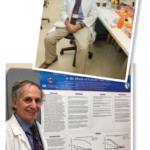The ACR also has a 30-minute commemorative DVD with member recollections and photo montages. The DVD will be distributed to rheumatology training directors to help them recruit physicians in their residency and fellowship programs, Amaker says. A number of distinguished rheumatologists took part in interviews for the DVD, says Shaun Ruddy, MD, professor emeritus at Virginia Commonwealth University in Richmond and chair of the ACR’s 75th anniversary task force.
Looking at ACR’s history
Those who helped plan for ACR’s diamond anniversary celebration acknowledge that the organization has experienced rapid growth and played a key role in the remarkable changes within the specialty.
The ACR began in 1934 as the American Rheumatism Association (ARA) with only a couple of hundred members; there are now more than 7,000 members in the ACR and just over 1,100 members in the ARHP.
The program for the first formal business meeting of the American Rheumatism Association listed 11 papers. As the meeting and the association grew in popularity, other spinoffs grew. For example, the Arthritis and Rheumatism Foundation was incorporated in 1948 as a voluntary health agency with ARA stimulus and sponsorship. In 1958, the ARA published the first issue of Arthritis & Rheumatism.1
After some discussion, the ARA merged in 1965 with the Arthritis and Rheumatism Foundation (by that time called the Arthritis Foundation [AF]).
The specialty began with a membership that was almost exclusively men; now, more than half of the trainees are women, Dr. Ruddy says.
When Dr. Ruddy began working in the field in the 1960s, there was no board examination; the ACR helped advocate for the creation of such an exam, he says. “I’ve benefited greatly from the organization,” he adds. In 1972, the first Rheumatology Subspecialty Board Examination was administered by the American Board of Internal Medicine.
The same year as its 50th anniversary, 1984, the ARA decided to end its association with the AF as a section and became its own independent organization, although the two organizations still have close ties. The ARA changed its name to the American College of Rheumatology in 1988. In 1994, health professionals in rheumatology decided to join with the ACR and ended their association with the AF—at which point they changed their name to the Association of Rheumatology Health Professionals.
Meeting the Challenges
One of the positive aspects of the ACR is that it leads rheumatology without splintering rheumatologists into subgroups, Dr. Ruddy says. “We probably have more academics percentage-wise than other specialties,” he says. Even still, both physicians in practices and those who work in higher education are well represented in the ACR, he believes.
